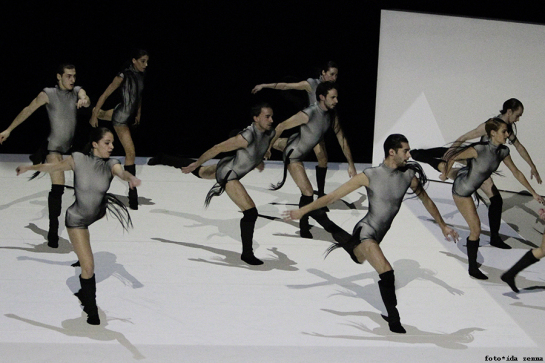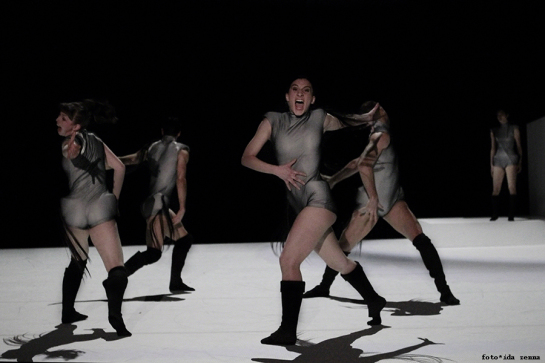HOWL – all electronic ballet score
Choreography: Maurice Causey
Video: Martin Grega
Costumes: Bodo Breg
Music: Gabriel Prokofiev ///
[all photos of Luzerner Ballet by Ida Zenna]
Luzerner Ballet, Switzerland, March – June 2013
Since September this has been my main instrument:
The ARP Odyssey
How did that happen?
Well, I’d been approached by choreographer Maurice Causey to work on a new commission for Luzerner Ballet in Switzerland. It was a collaboration that I’d wanted for some time as Maurice had already choreographed three of my compositions (and what I had seen of his work, was really special). We agreed that I would do an all electronic score for the 25 minute work.
I hadn’t composed a large-scale all electronic piece for at least 10 years, sure I’ve done lots of remixes for Nonclassical and also made many dance, grime and electro tracks up until quite recently, but not a big piece over 20 minutes, and as I’ve recently composed quite a few large-scale Orchestral works I was really curious to see how those experiences would affect my electronic composing.
Also, I decided to only use electronic source material. When I studied electroacoustic composition at Birmingham and then York, the standard approach was to make recordings of acoustic sounds as the source material and then process and sculpt them with electronics (usually computers). I really like this approach because acoustic sound sources instantly give you quite complex sonic material, and can quite quickly generate a very inspiring pallet of sounds after just a bit of processing. It seems that in the classical world less and less composers are working with purely electronically generated sounds, which were much more prominent in the early days, in the electronic work of composers like Stockhausen, Milton Babbit, Varese. In particular stand alone synthesisers are now mainly used in dance music and electronica and don’t seem to appear in modern classical compositions (except occasional use of ugly synth preset sounds in mixed ensembles).
So I thought why not try a large-scale composition that just uses a beautiful synth as it’s source. The early synths of the 1960s an 70s have now become highly collectable ‘vintage’ instruments, and a few companies (Moog, Korg, etc…) have re-issued their classic models; I think eventually these classic synths will be seen as instruments in their own right. They have a purity, simplicity and character of sound which continues to gain popularity in the popular music world, so why not enjoy their sound again in the classical score?
For my source sound for this work I chose a vintage Arp Odyssey synthesiser that I bought on bay a few years back. I’ve amassed quite a decent collection of analogue synths over the last 15 years and the Odyssey stands out as having the warmest and most beautiful tone, plus it has very powerful self-oscillating features, and can still create sounds that sound very contemporary.
I then spent many hours programming the Arp and finding the sounds that would suit the themes of our collaboration…
‘HOWL’
Maurice and I agreed that the main inspiration for this ballet would be the socio-political turmoil of the last few years; the protests, the battles and the revolutions. Like many people we had been greatly affected by watching these revolutions unfold live on TV, witnessing the struggles and desperate battles to change repressive governments. The work would be a semi-abstract exploration of the energy and emotions of those events; the desperation, the anger, the hope, the pain, the disappointment. There would be no exact narrative or continuous characters, rather a reaction/exploration through dance and music to the events, the images and the feelings. Then, Maurice made personal research into the broader theme of rebellion and in doing so remembered his favourite poem by Alan Ginsburg, ‘Howl’ which he felt was a perfect title for the piece and which also increased the focus on group/pack behaviour, and the idea of a desperate howl for freedom.
Meanwhile I realised that having a completely electronic score would reflect how electronics and computers have help facilitate a whole new wave of political expression. The way in which new technologies have empowered many previously unheard people is very exciting. Who would have expected that Facebook, Twitter and Skype of all things, have helped facilitate revolutions!
[And perhaps it’s also no coincidence that though Maurice Causey and me met through our respective art forms over two years ago, we didn’t meet in person until last November, I had only seen youtube videos of Maurice’s choreography, he had just downloaded my music on itunes, and out face-to-face meeting was on Skype! we were electronic collaborators already]
Maurice led the next step of the creative process by sending me a mood/emotion/tempo structural outline for the work, how he wanted it’s overall structure to be shaped. Then I got to work on composing many sketches and reactions to his basic structure:
Working method:
Once I had recorded source sounds from the Arp, I heavily processed, sequenced, and multi-tracked the various motifs, noises and sounds inside my computer. In particular, I focused on digitally degrading the sounds, in the same way that the digital signals on mobile phones, youtube videos, and skype calls are often distorted and degraded. Yet, despite using electronic sounds, I strove to create very expressive material; rhythms and gestures that have a soul, and at times a desperate driving energy.
Using electronics also allowed me to do certain compositional effects such as micro-tuning, and subtle layering of several different tempi simultaneously. At times I have also played with our experiences of time and tempo, placing fast pulses against slower tempos to create that ‘time-stands-still’ feeling we experience at tumultuous moments in our lives.
Of course once I got started working on ‘Howl’ I remembered one of the main reasons why I had stopped composing long electronic pieces: It takes so damn long! What I love about composing scores for live musicians, is that there is this second stage after the composing is finished; the interpretation by the musicians when they bring the score to life and bring all their experience and musicality to the score; turn it into a living work of art.
With electronic composition, everything has to be done in the studio, that magic of live performance that happens in an audience filled concert hall, has to have all been completely constructed in the studio, each nuance, phrase, rhythmic idea needs to be shaped and crafted in the studio; and ultimately that means listening through the piece many, many times! So it can be very slow work [Even in live electronics performances the amount of preparation needed to make sure the electronic instruments work as planned is incredibly time-consuming.] But at least I had the collaborative feedback from Maurice so I didn’t drive myself into complete delirium.
The exchange of demos from me, and feedback from Maurice continued for a couple of months and we actually restructured the ending of the work right up until the last 3 weeks before the premier. One sketch that we both loved but just didn’t work in ‘Howl’ eventually ended up as a humorous bonus piece called ‘Cock-a-doodle-doo’ which kind of acts as ‘live still goes on as usual’ epilogue.
Sound wise this work opens up quite a new sound pallet for me, and I can’t wait to release a CD of ‘Howl’, alongside several of the other sketches I made during the composition period, I’m curious how people from the electronica world will react to it.
As with my other work, I’ve not stopped influences from electronic dance music: techno, grime, hip-hop, etc.. from entering the language, but it never really falls into any of those genres. I rarely used any ‘standard’ drum sounds; I programmed a few ‘kick drum’ and fizzy Hi-hat type sounds (on FXpansions’ programmable analogue drum box), but I stayed away from standard electronica arrangement formulas, and the structure is generally less repetitive.
There are some lyrical moments, and I can’t deny being influenced by Messiaen’s seminal Ondes Martinot work ‘Oraison’ (1937), a work that shows just how sensitive and emotional electronic music can be.
Also, there are some slightly symphonic moments, with some quite thick harmonic progression rising out of more abrasive electronic textures.
The driving energy of this work is pushed against various distortions that the computer and the digital world force upon it… then through all the circuitry, the shouting, the drumming and the cries come calling out: just as millions of voices did during the last few years, and will continue to do so….
I have to write a few words about this masterful choreographer and dancer. His work has an incredible energy about it, not a showy or athletic energy, but a passionate emotional energy; and that’s what makes his work so captivating. I’m very fortunate that he discovered my music, and has already choreographed my first two string quartets and Concerto for Turntables & Orchestra.You can check out clips of his work on youtube, but really you need to see it in the theatre. Keep a look out for his next show, and check his biog: he has worked at the most progressive dance companies and was a lead dancer for Forsyth, who was one of the first to spot his serious talent.
Also, very important in this collaboration is Martin Greger, who has done the entire lighting of the show with 3 video projections. He has spent countless nights re-rendering his moving graphics to work with the dance, and was also a very positive part of the collaboration process. Lots of his more detailed video work was eventually cut from this production as it didn’t leave enough space for the dancers; however I’m hoping that we can make some kind of video piece out of that unused material at some point.
As shown by the photographs, star costume designer Bobo Berg, helped create an other-worldly setting for this ballet, with hair-pieces and shoulder & hip pads. And of course the brilliantly confident dancers of Luzerner Ballet under the suberb direction of Kathleen McNurney have brought this whole project howling into life…













